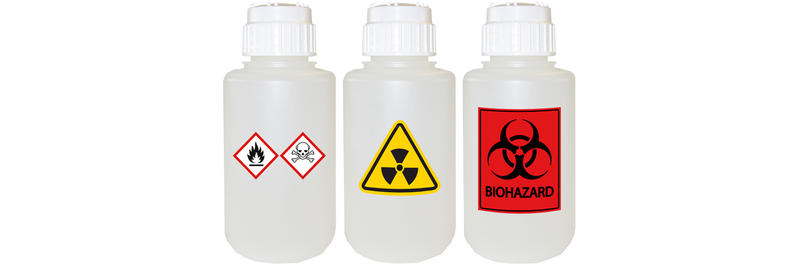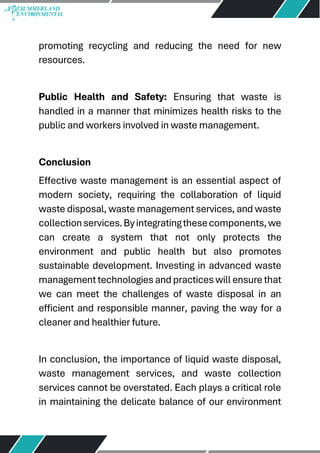Little Known Facts About Reclaim Waste.
Table of ContentsNot known Facts About Reclaim WasteReclaim Waste Things To Know Before You Get ThisTop Guidelines Of Reclaim WasteReclaim Waste Fundamentals ExplainedGetting The Reclaim Waste To WorkReclaim Waste for Beginners

Never place hazardous materials down sinks, toilets or stormwater drains pipes Substances including gasoline, grease, oil, chemicals and herbicides, and solvents such as paint pole dancers need to not be put down sinks, toilets or stormwater drains. These compounds are difficult to eliminate in the sewer treatment process and create pollution issues in our neighborhood rivers.

Although fluid waste is a term that covers a broad variety of materials, there's an excellent reason leaving its disposal to the specialists is recommended. Liquid waste is non-solid material that has no additional usage and has to be treated and dealt with according to regional, state and government guidelines.
Rumored Buzz on Reclaim Waste
Examples of fluid waste can consist of wastewater, fats, oils or grease, used oil, liquids, solids, gases or sludges and unsafe house fluids, there are some that are considered to be much more hazardous than others when it comes to the setting and the health and wellness of animals and people alike. It's consequently that each state and region have strict regulations connected to fluid waste management.
Liquid waste can be saved in holding storage tanks or packaged in drums, intermediate bulk containers or accepted little containers before either being dealt with or removed using outsourced vacuum cleaner trucks. Given the nature of the materials, liquid waste can not enter the basic waste stream and there are stringent policies on how to get rid of it correctly.
(https://hearthis.at/leon-aube/set/reclaim-waste/)Relying on a determination of the level of threat, it may be necessary to remediate those websites. Furthermore, hazardous fluid chemical wastes are regulated waste and has to be tracked in accordance with the state waste legislation. Under the chain of custody and duties, owners are liable and accountable for waste generated by a company.
One of the core applications for superabsorbent polymers (SAPs) is fluid waste solidification. liquid waste disposal. SAPs are made use of by waste administration experts to avoid possibly damaging liquids from entering rivers, groundwater aquifers, and other sensitive settings. Because liquids can swiftly transfer impurities into environmental receptors and potentially add to geotechnical failures, fluid wastes are generally banned from disposal in landfills
The Best Strategy To Use For Reclaim Waste
Basically, totally free liquids are liquids that separate from the solid portion of waste material. Liquid waste can consist of the following: HDD mud and cuttings Garbage dump leachate Wastewater therapy sludge & biosolids Dredged sediments Oil and gas drill cuttings Resolving pond muck Hydro Excavation slurry Coal combustion residuals/ash Tank bottom sludge Concrete grinding/polishing slurry Related Post: For a functional example of totally free liquids dividing from waste product, take into consideration the adhering to situation: A waste administration contractor loads a dump get redirected here associate sludge from a wastewater therapy plant's oygenation container, during a routine maintenance occasion.
When the motorist arrives at the landfill, he notifications water seeping from the sludge and pouring from the dump vehicle. The tons was rejected by the landfill and the driver was compelled to deal with the waste as a fluid waste at a special facility, which raised the disposal charges significantly.
We likewise need to be accountable for the proper disposal of our waste products. It is not sufficient that we pay waste disposal companies to take care of our rubbish.
Indicators on Reclaim Waste You Need To Know

Segregating your waste can begin inside the home. Segregate dry and liquid waste as well as edible waste, eco-friendly and non-biodegradable products.
Layer the bottom with dirt to absorb the damp waste. Layer the garden compost with damp and dry waste as well as soil to maintain a balance between the wet and the dry.
An Unbiased View of Reclaim Waste
To promote faster disintegration, you can likewise add semi composted dirt to the compost. If you discover the odor is becoming also strong, include additional newspapers and paper waste or add even more holes to the garden compost bin to keep the equilibrium of the waste materials.
We also need to be responsible for the correct disposal of our waste materials. It is not sufficient that we pay waste disposal companies to take care of our rubbish.
Our waste, our responsibility. Have you ever questioned what happens to your fluid waste after it's collected? Did you understand that fluid waste can be recycled? As responsible residents, you should understand what occurs to your rubbish and where it goes after it is taken away from you. Recognizing the fluid waste elimination procedure is necessary in assisting you to segregate your waste.
The 4-Minute Rule for Reclaim Waste
Segregating your waste can begin inside the home. Set apart dry and liquid waste as well as edible waste, naturally degradable and non-biodegradable materials.
You can utilize old garbage can, bucket, yard pot or old plastic drums. Pierce 4 to 5 openings in the container so the air can flow. Layer the base with soil to absorb the wet waste. Beginning the composting procedure. Layer the garden compost with wet and dry waste as well as dirt to keep an equilibrium between the wet and the dry.
To assist in faster decay, you can likewise add semi composted dirt to the compost. If you see the scent is coming to be as well solid, add added newspapers and paper waste or include even more holes to the garden compost bin to maintain the equilibrium of the waste products.